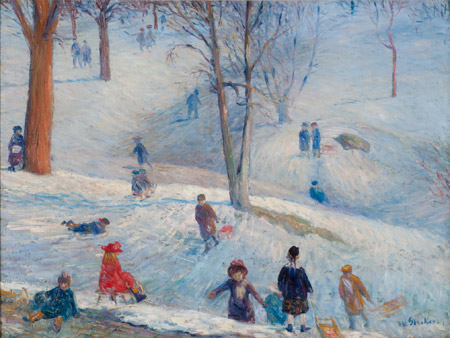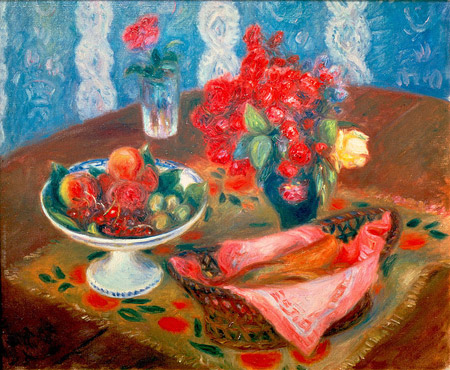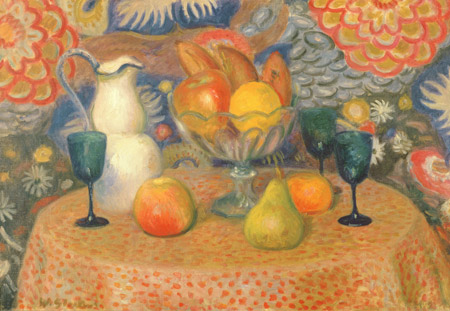In the early days of the 20th century, Picasso met some rich and careless Americans. “These folks,” Dave Hickey wrote in his book The Invisible Dragon: Essays on Beauty, “are no longer building gazebos and placing symboliste Madonnas in fern-choked grottos. They are running with the bulls — something Pablo can understand. They are measuring their power and security by their ability to tolerate high-velocity temporal change, high levels of symbolic distortion, and maximum psychic discontinuity.”
In Hickey’s version of the story of Modernism, it is these rich and careless Americans who finally shook the Europeans out of the torpor of late 19th century art making. The Americans were ready to face high-velocity temporal change and all the psychic discontinuity that goes with it. They were ready to face the Machine age, the Information age, the age of all things melting into air. Picasso’s portrait of prostitutes in a proto-Cubist tableau (les demoiselles d’Avignon) was, thus, made primarily for the rough and ready Americans who were prepared to understand such a picture.
There is truth to Hickey’s story. Gertrude Stein and her brother Leo were hosting their salon in Paris during the days when Picasso was looking for a new way to paint. The American expat community was restless, detached, and given to aesthetic excitability. The rich Americans dropping in from across the pond added fuel to the fire. They stirred money into a pot already filled with ambition and artistic discontent. A bomb was going to go off, and finally it did. The Steins provided the gunpowder. Picasso lit the fuse. Marcel Duchamp threw the bomb onto center stage.
The funny thing about this story is that the Americans who — in Hickey’s version — pushed Modernism along its course, seemed ill-prepared for the results that finally landed back upon their own shores. The landing came in 1913, at the famous Armory Show in New York City. At that show, Americans confronted European works of art that seemed to have metastasized dangerously from Picasso’s proto-Cubist ladies from Avignon just a few years earlier. Here were wild attacks of color from the Fauvists, machine-obsessed explosive paintings from the Futurists, extreme acts of spatial deconstruction from a now fully developed Cubism. And, of course, Marcel Duchamp’s Nude Descending a Staircase.
American artists were also represented at the Armory Show. Notably, the Armory Show included paintings by The Eight, eight artists all more or less inspired by Robert Henri, who was something of a guru to American painters around the turn of the century. Along with Henri, The Eight included Everett Shinn, John Sloan, Arthur B. Davies, Ernest Lawson, Maurice Prendergast, George Luks, and William J. Glackens. The Eight had been exhibiting together for about five years before the big Armory show. Their work had caused quite a bit of controversy. It was painting fully conversant with the trends in Impressionism and Post-Impressionism that came from Europe over the last decades of the 19th century and the first decade of the 20th. This kind of painting still had the capacity to shock and dismay critics looking for a straighter realism. For Americans used to looking at the paintings of Thomas Eakins, the work of Maurice Prendergast was difficult to metabolize, with its roughly sketched ladies, bold splotches of color, and streaky washed-out backgrounds.
Yet, compared to the new art movements coming from Europe, these American painters seemed tame. Placed alongside their European peers, The Eight went from being dangerous radicals to conservative reactionaries practically in the course of a single day. Some of the works at the Armory show dispensed with representationalism altogether, striking out into the clear blue yonder of Abstraction. The members of The Eight suddenly looked like they were picking about in the leftovers discarded by Europeans a generation past.
•

William James Glackens, Sledding in Central Park, 1912
Europe was on a collision course with itself by the time the Armory Show opened in the early months of 1913. By the end of the following summer, WWI would be in full swing. Trench warfare. Chemical warfare. The machine gun. Big Bertha with its 1,800-pound shells. Mechanized killing on a scale hitherto undreamt.
The horrors of WWI were a shock to most observers. But the destruction had actually been prefigured in the images of visual artists, the prose and poetry of writers, the ideas of thinkers. European civilization at the turn of the 20th century was, at least at the margins, disgusted with itself. The outbreak of an apocalyptic world war may have been surprising to politicians and military men. But artists had been playing with the idea on canvas and paper for years.
“It is in Italy,” wrote artist F. T. Marinetti in 1909, “that we are issuing this manifesto of ruinous and incendiary violence, by which we today are founding Futurism, because we want to deliver Italy from its gangrene of professors, archaeologists, tourist guides and antiquaries.” The Futurists were ready to take Italy — thick with the residue of 2,500 years of Western civilization — and throw it into the fires. Versions of the same sentiment could be found in France, England, Russia, Germany. Spiritual malaise and a rising anger were directed at everything and at nothing in particular.
In 1913, Franz Marc painted a picture called “Fate of the Animals.” Cubo-Futurist in appearance, the painting shows lines of color exploding through the bodies of deer, horses, and other animals. A soldier on the front lines two years later, Marc wrote a letter to his wife back at home. Marc told her he had received a postcard from a friend. The face of the postcard showed “Fate of the Animals.”
“When I saw it I was quite moved and excited,” Marc wrote. “It is like a premonition of the war, horrifying and moving … There is an artistic logic in having painted such works before the war, rather than their being stupid reminiscences after the war.”
Then a little bit later in the letter: “Generations will still think of this spring; the oldest people will tell about it later; the mood rises more and more to the incomprehensible.”
A year later, on March 4th, 1916, Marc was struck dead by an artillery shell during the Battle of Verdun. Marc was one of 700,000 casualties (dead, wounded and missing) from that battle, which lasted close to ten months and accomplished nothing.
•

William James Glackens, Still Life with Roses and Glass, 1924. Courtesy of High Museum of Art.
During WWI, and for many years to come, while European art was pulling itself apart and the European war machine was blowing itself to bits, William Glackens —
one of the American members of The Eight who exhibited at The Armory Show —
was painting lovely pictures of flowers. Glackens made seascapes and sun-dabbled interiors. He painted as if Impressionism had never ended, as if Modernism could have been halted just before the Cubist outbreak. You can see the results of this painting at The Barnes Museum in Philadelphia, which is exhibiting the first comprehensive survey of Glackens’ work in fifty years.
Looking at the paintings, one thing is clear. William Glackens had no desire to obliterate civilization. Born in 1870, he was just the right age to grow up looking at Impressionist paintings as new and exciting on the one hand, but already an accepted part of the canon on the other. He saw Renoir as both a revelation in new painting style, and as an iteration of an aesthetic continuity that could be traced back to Giotto. Glackens loved Modern art, but he had no interest, — as did Dave Hickey’s rich Americans visiting Gertrude Stein in Paris — in “high-velocity temporal change, high levels of symbolic distortion, and maximum psychic discontinuity.”
So, when looking at Glackens’ pictures, there are two questions you can ask. The first question is whether he is a good Impressionist painter. I suppose the answer to that is: He’s pretty good. He gets it. Glackens created plenty of pictures that wouldn’t be embarrassing to hang next to a Pissarro or a Monet. Glackens may have looked a little too often and too closely at late Renoir. It caused him to make paintings that have a soft and fuzzy glow. To temper this, Glackens studied Matisse. It made his color bolder. You can see that in a painting like Cape Cod Pier (1908), where an overabundance of orange and yellow adds an element of strangeness to the otherwise pleasing prettiness. Still, Cape Cod Pier could have been painted twenty years earlier than it was and not caused much of a stir. All in all, Glackens happily painted like it was 1878 until his death in a car crash in 1938.
But asking whether William Glackens was a good Impressionist painter raises a deeper question — whether Impressionism was attached to a particular, fleeting moment of history, or whether it was a way of making art that could, in principle, be practiced anywhere, anytime. Attempting to answer that question leads down into even murkier questions. Questions like: Does art progress? Does art develop? What is the relationship between art history and the rest of history?

William James Glackens, Still Life with Three Glasses, mid-1920s
It seems obvious, in retrospect, that the experiments in form and color that went from Courbet to Monet to Van Gogh and Gauguin would eventually lead to more radical moves, like Mondrian’s abstractions and the anti-art gags of Dada. But only hindsight makes this obvious. Looking at the work of Glackens, it’s just as clear that the history of art could have gone otherwise. American Realist painting all the way up until WWII makes the point that many roads were available. Art history always wants to tell a coherent, progressive story when, in fact, the story may not be coherent at all. There may not even be a story.
William Glackens did not have a philosophy of art or a grand theory of art’s development or lack thereof. His most eloquent contribution to all of these questions is, I think, his flower paintings. As he got older, Glackens made many pictures of flowers. It is hard to say that the flower pictures “develop” from one to the next. Glackens was already a mature artist when he really got into flowers. So, the flower pictures have an overall stability in terms of style—they are variations on a theme. The idea that he was supposed to discover a new way to paint flowers seems never to have occurred to Glackens. He already had a good way to paint flowers. The point wasn’t to learn more about painting flowers; the point was to paint more flowers.
That’s to say, in the later part of his life, Glackens appears to have painted flowers for the purpose of painting flowers. Some have seen in this a deepening fixation on mortality. Still lifes with flowers have long been associated with the memento mori. Glackens was thinking about death, the death of the flowers, quickly wilting in their vases, and then, by extension, his own death. Probably this is true. Aging painters have been known to reflect on the vanity of all things. Dust into dust.
But you can also see the flower paintings as a lively stubbornness on the part of Glackens. The artist put his foot down, aesthetically speaking. He’d called out “stop” to David Hickey’s vertiginous spiraling into maximum psychic discontinuity.
•
A woman in Sri Lanka once told me a story. She said that the rate of malaria among the British in Sri Lanka during the 19th century was much higher than in the local population. It was the vases of flowers, she told me. In the British households, they found it absolutely necessary to keep beautiful bunches of cut flowers in vases. These vases of standing water happened also to be perfect breeding grounds for mosquitos. The British were killing themselves with a stubborn sense of aesthetics.
That William Glackens would not let go of his vases of lovely flowers is, perhaps, a similar instinct. As the news came in from Europe that the 19th century was being destroyed, one artillery barrage at a time, Glackens walked back into his sitting room and arranged another bunch of flowers. He was going to keep painting, his way. That, too, is now part of the story of art and civilization in the 20th century. • 2 December 2014




